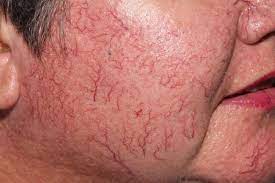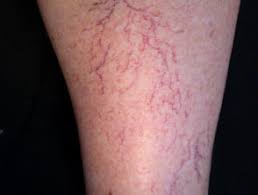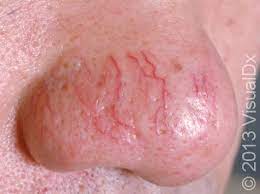Telangiectasias are small, widened blood vessels on the skin. They are usually harmless but may be associated with several diseases.


Telangiectasia other name Spider veins.
Telangiectasias, are small dilated blood vessels that can occur near the surface of the skin or mucous membranes, measuring between 0.5 and 1 millimeter in diameter.
They are commonly seen on the face around the nose, cheeks and chin, but, such dilated blood vessels can develop anywhere on the body.
They can also develop on the legs, and often have underlying venous reflux of varicose veins.
On the legs, they are found specifically on the upper thigh, below the knee joint and around the ankles.
Some telangiectasias are due to developmental abnormalities that can closely mimic the behavior of benign vascular neoplasms, composed of abnormal aggregations of arterioles, capillaries or venules.
Because telangiectasias are vascular lesions, they blanch.
Telangiectasias, are one of the features of the acronymically named CREST syndrome, a form of systemic scleroderma: calcinosis, Raynaud’s phenomenon, esophageal dysmotility, sclerodactyly and telangiectasia.
The causes of telangiectasia can be divided into congenital and acquired factors.
Inherited or congenital conditions that display cutaneous telangiectasia:
Bloom syndrome
Naevus flammeus (port-wine stain)
Klippel–Trenaunay syndrome
Maffucci syndrome (multiple enchondromas and hemangiomas)
Hereditary hemorrhagic telangiectasia (Osler–Weber–Rendu syndrome)
Ataxia–telangiectasia
Sturge–Weber syndrome, a nevus formation in the skin supplied by the trigeminal nerve and associated with facial port-wine stains, glaucoma, meningeal angiomas and intellectual disabilities.
Hypotrichosis–lymphedema–telangiectasia syndrome, caused by mutation in transcription factor SOX18
It was previously held that leg varicose veins or telangectasia were caused by high venous pressure, but venous reflux disease is usually the cause of these problems.
Telangiectasia in the legs is often related to the presence of venous reflux within underlying varicose veins.
Flow abnormalities within the medium-sized veins of the leg can also lead to the development of telangiectasia.
Factors that predispose to the development of varicose and telangiectatic leg veins include:
Age
Sex: 79% of adult males and 88% of adult females have leg telangiectasia (spider veins).
Pregnancy: Pregnancy is a key factor contributing to the formation of varicose and spider veins.
Changes in hormone levels are one of the most important reasons women are more likely to develop varicose veins during pregnancy.
There is an increase in progesterone, which causes the veins to relax and potentially swell more easily.
There’s also a significant increase in the blood volume during pregnancy, which tends to distend veins, causing valve dysfunction which leads to blood pooling in the veins.
Later in pregnancy, the enlarged uterus can compress veins, causing higher vein pressure leading to dilated veins.
Varicose veins that form during pregnancy may spontaneously improve or even disappear a few months after delivery.
Individuals involved with prolonged sitting or standing in their daily activities have an increased risk of developing varicose veins.
The weight of the blood continuously pressing against the closed valves causes them to fail, leading to vein distention.
Other acquired causes of telangiectasia:
Acquired telangiectasia, not related to other venous abnormalities, for example on the face and trunk, can be caused by factors such as
Cushing’s syndrome,Rosacea,Blepharitis
Environmental damage such as that caused by sun or cold exposure
Age
Trauma to skin such as contusions or surgical incisions.
Radiation exposure such as that experienced during radiotherapy for the treatment of cancer
Chemotherapy
Carcinoid syndrome
Limited systemic sclerosis/scleroderma
Chronic treatment with topical corticosteroids may lead to telangiectasia.
Spider angiomas are a radial array of tiny arterioles that commonly occur in pregnant women and in patients with hepatic cirrhosis and are associated with palmar erythema.
In men spider angiomas are related to high estrogen levels secondary to liver disease.
An association between leg telangectasia and underlying venous reflux exists.
88% to 89% of women with telangectasia (spider veins) have refluxing reticular veins close, and 15% have incompetent perforator veins nearby.
Sclerotherapy is the is preferred over laser for eliminating telangiectasiae and smaller varicose leg veins.
A sclerosant medication is injected into the diseased vein so it hardens and eventually shrinks away.
With foam sclerotherapy the irritating sclerosant quickly appears in the patient’s heart and lungs, and then in some cases travels through a patent foramen ovale to the brain, leading to concerns about the safety of sclerotherapy for telangectasias and spider veins.
In some cases stroke and transient ischemic attacks have occurred after sclerotherapy.
Risks that occur with sclerotherapy are DVT, pulmonary embolism, and stroke.
Telangiectasias on the face are often treated with a laser,
using a light beam that is pulsed onto the veins in order to seal them off, causing them to dissolve.
These treatments can result in the destruction of sweat glands, and the risk increases with the number of treatments.
